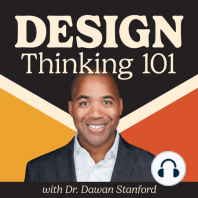62 min listen

Micro Course: How to Conduct Listening Sessions with Indi Young — DT101 E64
Micro Course: How to Conduct Listening Sessions with Indi Young — DT101 E64
ratings:
Length:
85 minutes
Released:
Mar 2, 2021
Format:
Podcast episode
Description
In this episode, Indi Young joins me to deliver a micro-course on listening sessions. I’m experimenting with new ways to learn on the podcast. Listeners will learn from Indi as we talk about listening sessions, what they are, how to do them, why they matter, and how to get the most out of them. Let me know what you think of the micro-course format, and if I should do more of them. Cheers, Dawan, Your Design Thinking 101 Podcast Host Listen to learn more about: What listening sessions are and why they matter How to structure a good listening session Getting the most out of listening sessions The two questions that are always asked during a listening session Do’s and Don’ts of listening sessions Our Guest’s Bio Indi Young is a researcher who coaches, writes, and teaches about inclusive product strategy. Her work is rooted in the problem space where the focus is on people, not users. Indi pioneered opportunity, maps, mental model diagrams, and thinking styles. She was one of the founders of Adaptive Path, the pioneering user experience agency. Her way of approaching the problem allows teams to truly pay attention to people without letting cognitive bias and assumptions creep in. She has written two books, Practical Empathy, and Mental Models, and is working on a third, Assumptions Aside, which will cover thinking styles. Indi builds knowledge and community via a series of online advanced courses about design research and the importance of pushing the boundaries of your perspective. Show Highlights [02:54] Listening is different from interviewing. [03:22] Listening is qualitative research. [04:35] Indi describes the knowledge creation / data collection template she uses. [05:05] Problem spaces and solution spaces. [06:57] In the solution space, much of the research is either generative or evaluative. [08:07] In the problem space, the research is neither generative nor evaluative. [08:54] The problem space is interested in the person and how they achieve their purpose. [09:19] A listening session asks the person what they were thinking as they were achieving their purpose. [11:25] Organizations are often only concerned with solution spaces; problem spaces tend to get ignored. [12:03] Why study problem spaces? [12:56] One solution does not fit all – there is no such thing as an “average user.” [13:50] Thinking styles vs. personas, and designing for archetypes. [15:03] An example from work Indi did for the University of Buffalo. [15:33] The benefits of using thinking styles over personas. [16:25] The bias problem in research. [17:10] Listening sessions must be framed by a purpose, and must have depth. [17:39] Surface vs. depth. [18:59] Depth is how we develop cognitive empathy with people. [19:34] The good stuff in a listening session is the inner thinking, the emotional reactions. [21:13] Indi describes the Mental Model Diagram. [23:27] Listening sessions start with a germinal question. [24:28] Listening sessions are audio-only. [26:49] The challenges that can come up in listening sessions. [28:47] The structure of a listening session. [30:27] Indi shares snippets of some listening sessions as examples of how to begin a listening session. [34:37] How Indi works with the results of a listening session. [35:14] Techniques used during listening sessions. [36:13] Listening session examples demonstrating techniques Listeners can use to build trust and rapport with the Speaker. [38:05] The importance of silence. [41:29] Listening session examples demonstrating how to encourage Speakers to open up and share their inner thoughts and emotions. [45:38] Indi talks about micro-reflections and shares some examples from listening sessions. [49:57] Why Indi likes the word “because.” [50:43] Listening session examples where the Listeners used time and place to help the Speakers dig deeper. [Note from Indi at 51:44] - “I forgot to explain that the grocery store example was because the Speaker got flustered and forgot her restaurant ex
Released:
Mar 2, 2021
Format:
Podcast episode
Titles in the series (100)
Healthcare Design Teams + Wellness + ScienceXDesign with Chris McCarthy — DT101 E24: Welcome to the Design Thinking podcast! I’m Dawan Stanford, your host. Today I’m interviewing Chris McCarthy. He is the Vice President of Strategy & Design at Hopelab where he is excited to deepen its impact on the health and wellness of young... by Design Thinking 101